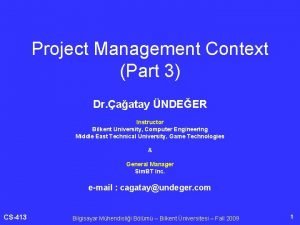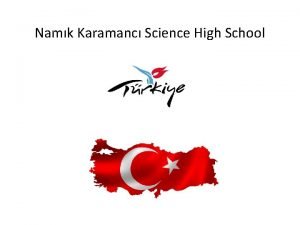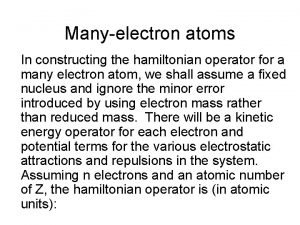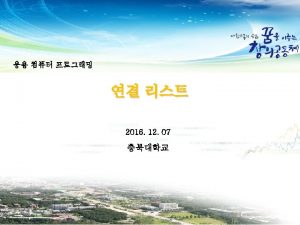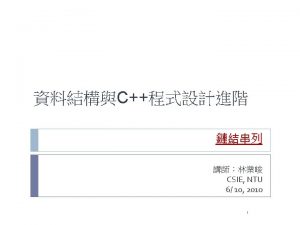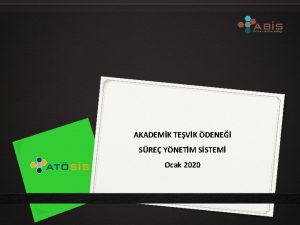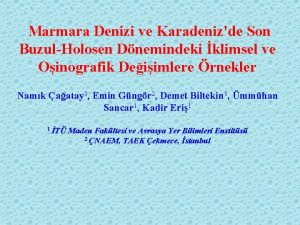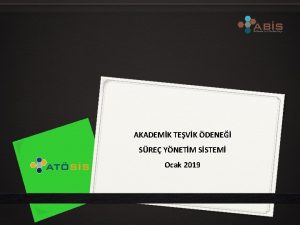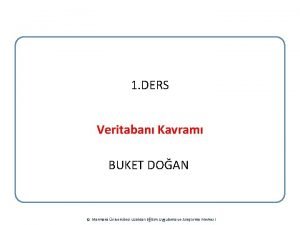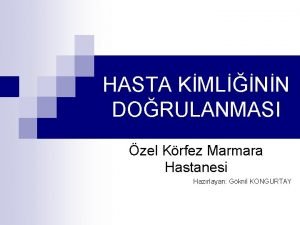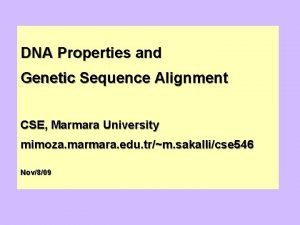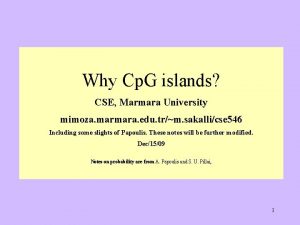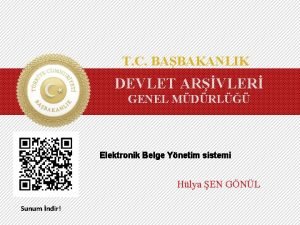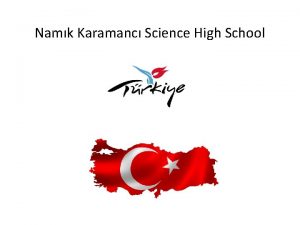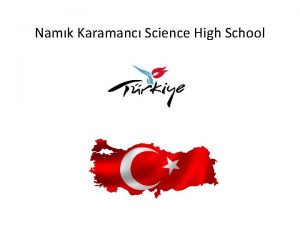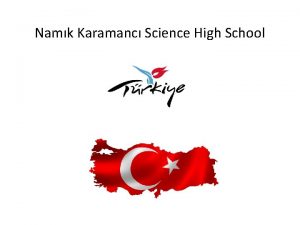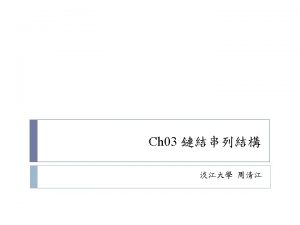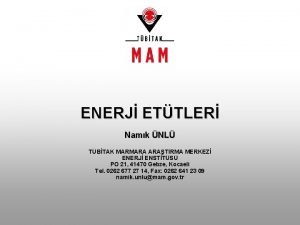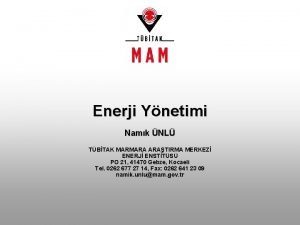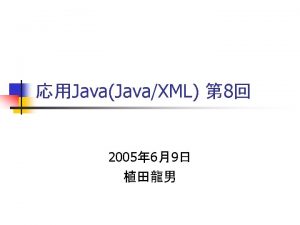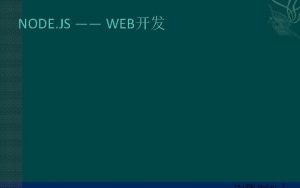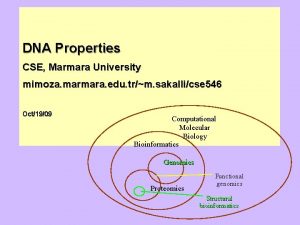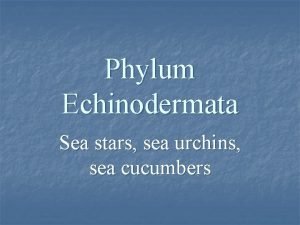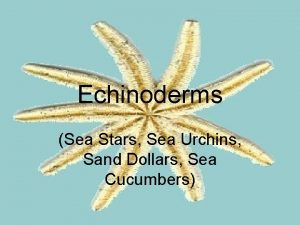SEA OF MARMARA NODE EMSO ACTIVITIES Namk aatay

















- Slides: 17

SEA OF MARMARA NODE EMSO ACTIVITIES Namık Çağatay İTÜ EMSO-Preparatory Phase ESONET-EMSO All regions Workshop 5 -7 October 2009

Morpho-tectonics: Geohazards 1912 Ms=7. 4 1999 Mw=7. 4 Fault lines modified after Armijo (2003) and Le Pichon (2001)

Distribution of population and Industy in the Marmara Region: Anthropogenic inputs 30 % of Turkey’s population more than 50% Turkey’s industry located in this region Inputs from Black Sea Heavy maritime transport Natural sediment inputs mainly from the southern drainage basin Mater and Gürpınar (1992)

Main features of Sea of Marmara as an EMSO node Ø Geotectonic setting on the North Anatolian Fault: Earthquake, submarine landslide and associated tsunami risk Ø Oceanographic setting between Mediterranean Sea and Black Sea Ø Environmental risks of pollution from industrial, municipal and maritime transportation

Observatory Locations Three important observation site a) Tekirdağ B. -W. High b) İstanbul c) east Çınarcık 3 He Tekirdağ Western High Central High Sesimic gap Sea of Marmara Çınarcık

Sea of Marmara Observatory Design • • • Multidisciplinary: geoscience and oceanography Permanent, cabled to the shore (real-time transmission) Clock synchronization SENSOR Manifacturer & model Sampling interv. Seismometer (OBS) GURALP CMG-40 T 100 Hz Piezometer Ifremer Hydrophone OAS E-2 PD 100 Hz Current meter NOBSKA MAVS-3 5 Hz CTD Sea. Bird SBE-16 plus 1 sample/ 10 min Turbidometer WET LABS Echo-BBRTD 1 sample/10 min Methane #1 Franatech METS 1 Hz Methane #2 Contros Hydro. C 1 Hz Oxygen probe Aanderaa Oxygen Optode 3830 1 Hz 1 sample/min

Flexible, open to future development and connection of new sensors Shore station Copper + Optical cable Gas bubble monitoring --SN 4 --Other instruments OBS Junction box OBS Piezo 7

Stakeholders list in Turkey: Major governmental research and public organizations in the Sea of Marmara 1) ITU-EMCOL (Eastern Mediterranean Centre for Oceranography and Limnology (http: //www. emcol. itu. edu. tr/). 2) General Directorate of Mineral Research and Exploration (MTA) (http: //www. mta. gov. tr). 3) Petroleum Company (TPAO) (http: //www. tpao. gov. tr) 4) Turkish Navy Office of Navigation, Hydrography and Oceanography (TN-ONHO) (http: //www. shodb. gov. tr/english. html) 5) Turkish Coast Guard Command (http: //www. sgk. tsk. tr/en_index. htm) 6) Turkish Coastal Safety and Rescue General Directorate 7) Kandilli Earth Obsevatory of the Bosphorus University (KOERI) (http: //www. koeri. boun. edu. tr/) 8) Marine Sciences Institute of the Middle East Technical University (http: //www. ims. metu. edu. tr/) 9) Institute Earth and Marine Sciences, TUBITAK-MRC (http: //www. mam. gov. tr/YDBE/index. html)

Stakeholders list in Turkey (continued) 10) Union of municipalities in the Marmara region 11) Marine Sciences and Technology Institute of Dokuz Eylül University İzmir (http: //www. deu. edu. tr/DEUWeb/Icerik. php? KOD=74) 12) Marine Sciences and Management Institute of the Istanbul Univeristy (http: //www. istanbul. edu. tr/enstituler/denizbilimleri/ turkce/turkish. htm) 13) Turkish Marine Research Foundation (http: //www. tudav. org/new/eng/) 14) İnönü Foundation Marine Research Centre (www. ismetinonu. org. tr) D 2. 4. Reaching an official agreement between key stakeholders for the work in the Sea of Marmara Node.

EMSO Marmara Node Project Meeting of Turkish stakeholders on 29 May 2009 Attended by the Vice-Rector of ITU for Research and representatives of stakeholders (major research institutes and government organizations) The main points of consensus reached: Considering EMSO project being important for the So. M, the stakeholders will constitute a consortium, and apply to Turkish Government with a project proposal for the establishment of the EMSO Marmara node infrastructure

Implementation Plan for Observatory Infrastructure Project proposal to be submitted to Turkish Government by May 2010 will cover Capex and Opex for three years. The proposal need to justify: • Societal and scientific needs • Long-term sustainability of infrastructure (operation and maintenance) 1) ITU administration will consider the project as high priority one and provide office space, personnel and other support 2) MTA will provide ship services for operational and maintenance purposes 3) Support letters from organizations that could contribute to Opex

Meeting with the Union of Municipalities in the Marmara Region : 1 October 2009 • a support letter for the project proposal, stating contribution towards operational expenses Meeting with SMEs planned during November 2009 • Important for showing the technological and economical aspect of the observatories.

Other Financial Work Industrial funding • Turkish Petroleum Company (TPAO) (http: //www. tpao. gov. tr): A seminar about EMSO and ESONET projects and project activities in the Sea of Marmara node was presented to the technical and scientific staff of TPAO in Ankara on 19 February 2009. • Private petroleum companies with exploration concession in the Sea of Marmara were also informed about the EMSO and ESONET in June 2009: a) Merty Energy and Petroleum Exploration b) Toreador Turkey Limited c) Thrace Basin Natural Gas Türkiye Corporation

WPs 4&7 Financial and strategic work (continued) To generate funding in Turkey, we need support through workshops demonstrating the use of seafloor observatories to funding organizations, related industries, scientific community and public at large

WP. 3. Legal Work National Legislation (Task 3. 2) • Worked with the Legal Department and EC Project Office of the ITU. The result is that there is no legislation in Turkey specifically related seafloor observatories. • Permission from Marine Affairs Department needed (KOERI’s experience). • According to the Turkey's environmental legislation there is no need for Environmental Impact Assessment (EPA) (http: //www. cedgm. gov. tr/mevzuat/yonetmelik/cedyonetm eligi. htm for a typical deep seafloor observatory set up. • In case the observatory is a coastal one, the Ministry of Public Works and Settlement (http: //www. bayindirlik. gov. tr/english/index. php should be informed.

WP. 3. Legal Work (continued) The deployment and security issues for seafloor observatories concerns mainly two governmental Departments in Turkey : • Department of Navigation, Hydrography and Oceanography (TN-ONHO) of Turkish Navy (http: //www. shodb. gov. tr/english. html) • Turkish Coast Guard Command (http: //www. sgk. tsk. tr/en_index. htm) We had meetings with these organizations concerning these issues. Trawling and ship anchorage are important risks for seafloor cables and observatory stations.

Acknowledgements Special Thanks • Louis Geli (Ifremer), Pierre Henry (CNRS, College de France), Yves Aufrett (Ifremer) • Luca Gasperini (ISMAR- Bologna), Paolo Favali (INGV)
 Aatay
Aatay Namk
Namk Russell-saunders coupling
Russell-saunders coupling Reference node and non reference node
Reference node and non reference node Struct node int data struct node* next
Struct node int data struct node* next Wavelength constructive interference
Wavelength constructive interference Typedef struct in c
Typedef struct in c Reference node and non reference node
Reference node and non reference node Marmara atösis
Marmara atösis Marmara denizi fay hattı
Marmara denizi fay hattı Marmara atösis
Marmara atösis Marmara veri tabanı
Marmara veri tabanı Körfez marmara hastanesi tahlil sonuçları
Körfez marmara hastanesi tahlil sonuçları Cse marmara
Cse marmara Marmara cse
Marmara cse Arsivebys.marmara.edu.tr
Arsivebys.marmara.edu.tr Yellow sea and east china sea
Yellow sea and east china sea Hydra jellyfish sea anemone sea urchin
Hydra jellyfish sea anemone sea urchin
